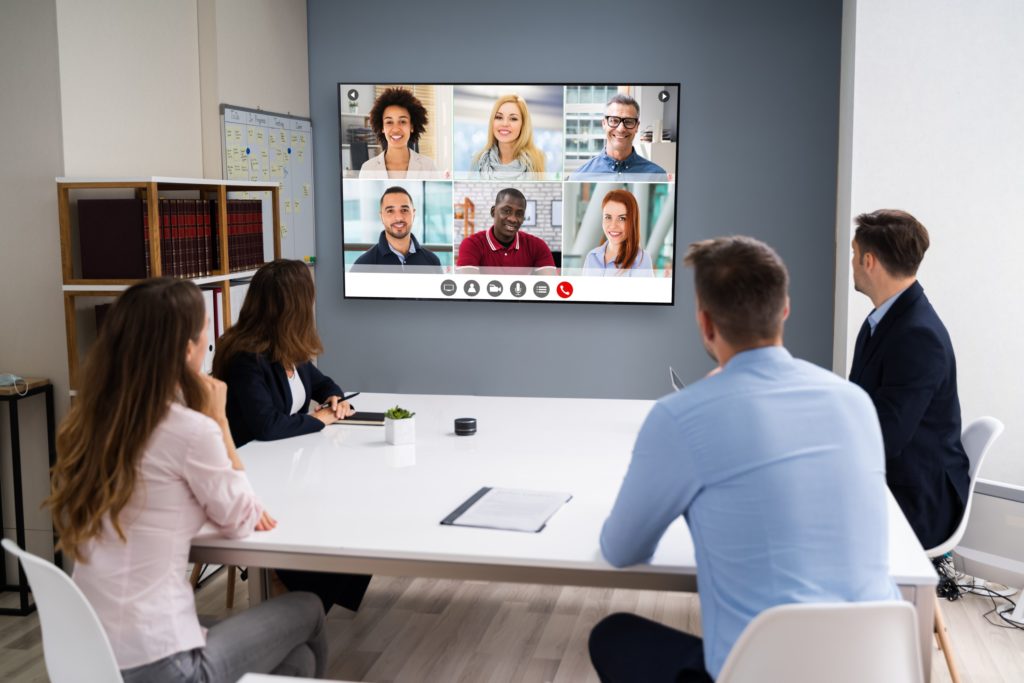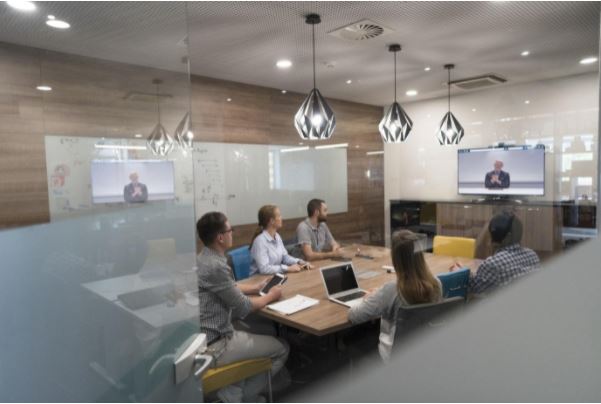In this Article...quick links
Do you remember those seemingly endless hours spent commuting to the office day after day?
Did you long for greater flexibility and the chance to work from home?
Well, fast forward 16 months and it’s likely you are sick and tired of working from your kitchen table and can’t wait to get back to the office and interact face-to-face with your colleagues, well, at least for some of the time anyway.
This new hybrid life of yours will now also include something else new – running hybrid meetings.
Even when Covid-19 restrictions are fully lifted it’s clear, in almost every country around the world, that businesses will not return to the same way of working, where every employee is in the office five days a week and presentations and meetings are once again all face-to-face.
But it’s also clear that neither will meetings or presentations all be online.
Meetings themselves will begin to meet in the middle, adopting a bit of both approaches (online and face-to-face) in a third way – the hybrid meeting!
The recent Global Workforce Survey conducted by Dimensional Research predicts that hybrid meetings (a combination of in-person and virtual attendees) will become the new norm, and around 98% of post-Covid meetings will have at least one remote participant.
The survey also found that over half of employees plan to work from home 8 or more days a month.
Virtual meeting platforms and online collaboration tools have transformed the way we work together and greater flexibility leads to happier and more productive employees.
Microsoft’s 2021 Work Trend Index (conducted across 31 markets) identified a definite desire by workers to change the way they work in the future by combining some days in the office with flexible, remote work options.
But, conducting a successful hybrid meeting is actually a lot harder than you might think.
Face-to-face and online meetings both have their own challenges and so any successful hybrid of these will have to consider their challenges, as well as those unique to a combined meeting environment.
So, we’ve put together some top tips and best practices to help you navigate your way before, during and after a hybrid meeting.
But first, we’ll highlight three of the most obvious challenges that a hybrid meeting presents and how these can be overcome.
#1. Virtual meetings are far more tiring for remote attendees than for those attending in-person.
Zoom fatigue is real (read about how to avoid it here), so consider having shorter meetings: think about running 20 or 45-minute meetings rather than 30 or 60-minute meetings. Any longer than this and you need to factor in break times.
And, also remember with hybrid meetings, that those attending in-person can, and do, often get up, grab a coffee, go to the window or walk around the room to think during a meeting – when they do, they’re still in the room, in the meeting.
Participants online don’t have this luxury because when they get up they have effectively ‘left the room’ and the meeting.
#2. In hybrid meetings communication has less ‘flow’ and is not as smooth and efficient as in pure in-person meetings.
You’ll need to allow extra meeting time to compensate for this.
This may seem like it’s contradicting the point above. But it isn’t. We’re simply recommending that you should aim to cover less material during a hybrid meeting.
This will enable you to have shorter meetings but have more time to cover what needs to be discussed.
To help make hybrid meetings more efficient, send the agenda and slides in advance along with as much pre-reading as you can. This way, attendees will be prepared with their feedback, questions or concerns at the start of the meeting.
#3. Virtual attendees are easily distracted and may disengage during the meeting.
So we suggest appointing a Meeting Chair as the solution.
The role of the Chairperson during hybrid meetings is extremely important. In fact, a lot more so than for ‘traditional’ in-person meetings.
A hybrid meeting Chair needs to first check that everyone attending in-person and virtually can clearly hear and see everyone else. You don’t want to be stopping every few minutes because you’ve realised people can’t hear/see each other.
The Chair also needs to carefully monitor people’s participation and contribution levels throughout the meeting, especially amongst those attending remotely.
Failure to help facilitate their participation will quickly disengage those attending virtually, create an ‘us and them’ atmosphere and erode the success of the meeting.
We’ll be sharing techniques to manage this later on.
Hybrid Meetings Best Practices
#1 SETTING UP A HYBRID MEETING OR PRESENTATION
- What room is being used for those attending in-person and are there attendee limits?
- Is PPE, or social distancing expected in the room and the surrounding area?
- What equipment (laptop, earbuds, etc.) should attendees bring?
- To create a more level playing field (and this might sound strange at first) do you want the in-person attendees to join the meeting via the VC platform so everyone is effectively online together (albeit some will also be in the same room together)?
- If not, how will the video and audio work? It’s vital that the virtual attendees can see and hear everyone in the room clearly. Otherwise, they will be at a disadvantage. Poor quality audio, and a narrow field of view camera, can make a hybrid meeting almost pointless. So, ensure your meeting room is equipped with quality external speakers such as these by Jabra, individual table -top microphones and a proper conference room webcam.
- As colleagues/attendees could be anywhere in the world in a hybrid meeting do you need to set a common universal language? If not, how will this be overcome? Will you need a translator?
- Will slides or documents need to be shared? How will this work so everyone can see them?
- How will you manage questions? If you’re going to use Chat, who will monitor and manage this? It’s a good idea to appoint an “in person” attendee to login to the meeting as if they were attending remotely. This individual can look out for questions, feedback or issues from the virtual attendees and share them with the entire group, either as they come in, or in ‘batches’, at certain times during the meeting.
- Likewise, will you want to use online polls, and if so, how will that work with people attending in-person?
- Have a back-up plan in case the remote technology fails. This could be an alternative VC platform or even just a conference phone.
In addition to the points above, there are a myriad of technical aspects to hybrid meetings that are worth considering. The Harvard Business Review has published some good advice on this.
#2. DURING A HYBRID MEETING OR PRESENTATION
- Be on time and stay on time. It might be acceptable for people to wander about a meeting room or come in a few minutes late, but for those attending online it’s at best disruptive and at worst, highly irritating.
- Everyone should be seen. It’s especially important for virtual attendees that they can see who is talking, so make sure everyone faces the camera.
- Acknowledge and introduce your online colleagues. Give your remote attendees a shout-out at the start to help make them feel just as important as those in the room. Explain their roles (if not known) and why it’s important to the meeting objectives that they are present.
- Strong facilitation is crucial. The chairperson should manage the agenda and keep conversation on track. He or she should also make sure remote attendees are heard and their opinions sought; it’s very easy for in-person attendees to dominate the discussion and this can lead to dis-engagement by those attending virtually. In the same vein make sure there are no side conversations or situational jokes, unless shared amongst the whole meeting.
- Choose a call-out word that you call out if anyone is disregarding or bending the meeting etiquette. The meeting can select a humorous word to lighten the tone. It’s nicer to nudge people to be considerate of their remote colleagues in rather than telling them off like a parent.
- Don’t rush the agenda. Pausing at the end of each section will encourage online participants to raise questions and request clarification. If the discussion is being overshadowed by those in the room, then stop and invite comments from the remote audience.
- Treat everyone equally. When you are speaking make sure you make eye contact with online attendees as well as those in the room. Perhaps make a point of interacting with them first rather than turning to the person next to you. Validate their questions, encourage their participation and keep them engaged. Avoid putting them on the spot but do ensure they don’t just become viewers.
- Look out for cues. Assuming their cameras are turned on keep an eye out for body language and facial cues such as puzzled faces, raised eyebrows or even disengaged behaviour. Use these as an opportunity to bring them into the conversation and clarify any concerns. Similarly, if someone unmutes themselves it’s an indication that they might have something to say. Make sure they have the opportunity to do so.
- Replicate roles. If you are brainstorming or using break-out groups in the room then make sure the remote participants have a virtual whiteboard to do the same. Virtual collaboration platforms make this easy to do.
- Keep the playing field level. Consider using polls for everyone, whether in-person or remote, rather than ask for feedback so that everyone has the same opportunity to voice their opinions.
- Make notes. Sounds obvious and it is. But make sure someone is appointed to capture all important actions and discussions. Share these in a timely manner via internal platforms and collaboration workspaces. www.otter.ai integrates with Zoom and automatically captures meeting audio and converts to text
#3. AFTER A HYBRID MEETING OR PRESENTATION
These are new times and these are new ways of working. Hybrid meetings and presentations will require getting used to. And how they work will no doubt evolve as we get more familiar with them.
Technology companies are already focussed on creating new platforms especially designed for the hybrid meeting format. But in the meantime, it’s also important to get feedback from everyone attending – in-person and virtually.
Ask them:
- What’s working well?
- What’s not working so well?
- What could we do more of, less of, or differently to enhance the experience for everyone and the meeting/presentation outcomes
—
Improve your hybrid meeting & presentation skills further!
Keen to learn more about how to successfully present and manage a hybrid meeting? Then look at tailored training to lift your in-person and online presenting skills.
For nearly 20 years we have been the Business Presentation Skills Experts, training & coaching thousands of people in an A-Z of global blue-chip organisations – check out what they say about our programmes.
To find out more, click on one of the buttons below:

Belinda is the Co-Founder and Managing Director of SecondNature International. With a determination to drive a paradigm shift in the delivery of presentation skills training both In-Person and Online, she is a strong advocate of a more personal and sustainable presentation skills training methodology.
Belinda believes that people don’t have to change who they are to be the presenter they want to be. So she developed a coaching approach that harnesses people’s unique personality to build their own authentic presentation style and personal brand.
She has helped to transform the presentation skills of people around the world in an A-Z of organisations including Amazon, BBC, Brother, BT, CocaCola, DHL, EE, ESRI, IpsosMORI, Heineken, MARS Inc., Moody’s, Moonpig, Nationwide, Pfizer, Publicis Groupe, Roche, Savills, Triumph and Walmart – to name just a few.






